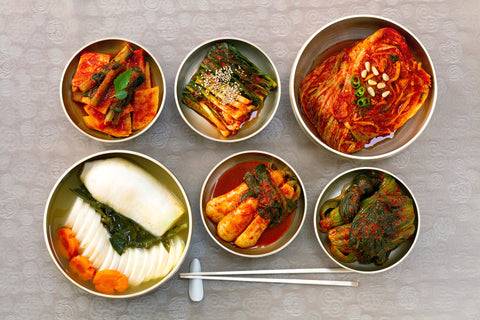In the frigid winters of the ancient Korean Peninsula, its people found themselves enveloped in thick snow. Fresh food was rare, and vegetables even scarcer. Faced with the biting cold, they were determined to satisfy their hunger, turning to an innovative solution: the art of fermentation.
Fermentation has a long history in Korean gastronomy dating back thousands of years when the country was still reigned by three kingdoms. It was a necessity during those periods as refrigeration was not easily accessible, and people needed to store and preserve food to prevent starvation during long and harsh winter days.
After years of experimenting, the Koreans mastered the method of fermentation. They tried fermenting fresh ingredients such as fish (jeotgal), vegetables (kimchi), and salted beans (jang). They would preserve them in big jars called hangari or onggi and would eventually discover that fermenting results in distinct and refreshing flavors. With such discovery, they have transformed adversity into an opportunity for culinary creativity.
The food that cures
Long before the emergence of health technology, a longstanding Korean food culture embraced fermented food as a remedy for various ailments. Although they then lacked an advanced understanding of the acids and enzymes produced during fermentation, Koreans recognized the health benefits of fermented food.
They indulge in vegetables and other healthy foods evident in what they call banchan, or side dishes, that mostly consist of fermented or pickled vegetables. This follows a part of their traditional food philosophy of not eating just for the sake of satisfying their hunger; they believe that food is made and eaten to be healthy.
The most familiar banchan is kimchi. This icon of Korean cuisine is traditionally made with salted Napa cabbage (baechu), Korean red pepper flakes (gochugaru), garlic, ginger, scallions, fish sauce, shrimp paste, among other ingredients. A well-fermented kimchi combines spicy, sour, tangy, and a slight sweetness when a small amount of sugar is added.
Apart from its very distinct flavor, kimchi is also seen as a superfood containing vitamins A, B, and C, and a probiotic called Lactobacillus, which are also present in yogurt and yogurt drinks. This probiotic helps aid digestion, strengthens the immune system, allows proper nutrient absorption, and removes toxins or harmful microbes in our bodies. Studies also show that eating fermented food boosts immunity; it helps strengthen the liver, supports the gallbladder, and maintains the proper balance of healthy bacteria for intestinal health.

A long-standing culture
Korean families have been serving kimchi on their tables for thousands of years; it is a staple incorporated into every meal. It has become customary for every home to prepare batches of kimchi in anticipation of winter. Across diverse Korean regions and households, other varieties of kimchi emerged, shaped by distinct ingredients and salting techniques. Radishes, in lieu of cabbage, find their way into some renditions, showcasing the creative diversity within this culinary tradition. Preparing exceptional kimchi hinges on selecting quality raw materials, as these ingredients harbor the essential microorganisms vital to fermentation.
The cultural significance of kimchi is amplified through the communal tradition known as Kimjang, an annual event where Koreans come together to prepare large quantities of this iconic dish. Kimjang is a collective effort within families and communities, ensuring that each household has an ample supply of kimchi to sustain them through the winter.
Although the actual kimchi-making happens near the winter season, Kimjang is a year-round process, with preparations beginning in spring when anchovies and seafood are salted and fermented. Spices for the brine are acquired, and red chilies are dried and powdered during the summer.
During Kimjang, kimchi is traditionally preserved in large jars buried in the soil to achieve its signature fermented taste. While some Koreans, especially in the provinces, still follow this practice, many now opt for refrigeration.
Usually, the oldest female in the family leads the traditional Kimjang. To preserve this tradition and the recipe—an integral part of the family history and Kimjang culture—they gather all female family members together to help make kimchi. This has become the key to Kimjang’s long-standing tradition.
This rich culinary tradition in Korea represents a profound philosophy that transcends taste. For them, food is more than just a source of nourishment; it's also a form of medicine, evident in complex banchan like kimchi and other fermented delicacies. It is also a remembrance of resilience, recalling how what was once a survival tool to combat hunger during the cold seasons has developed into a fundamental aspect of Korean cuisine, with a lasting legacy and tradition that has in turn sustained Korean communities and families for years.





